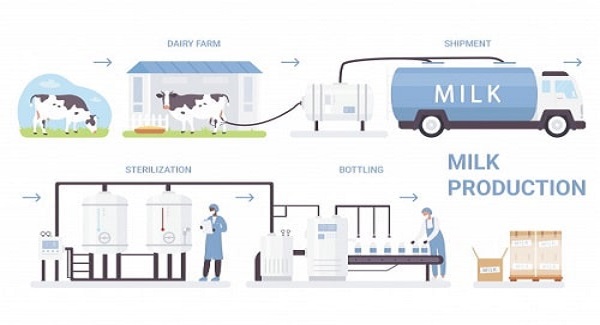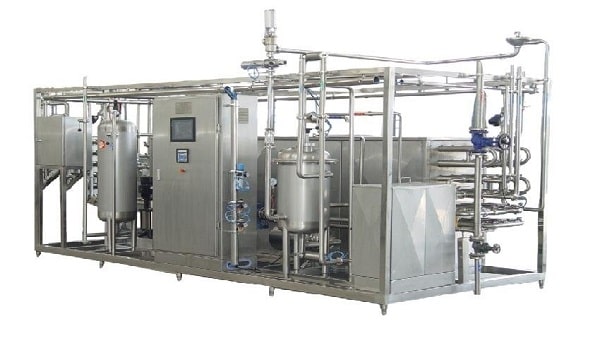Equipment used in dairy production lines should be made of stainless steel, which is less polluting.
Miscellaneous companies produce and market equipment using low quality raw materials. The use of these products affects the quality of the final product, which is very sensitive and must be free of any contamination.
Global brands such as Alfa Laval are leaders in the production of stainless steel equipment and the founder of dairy lines in many countries.
In the following, the production steps of pasteurized and sterilized milk in the factory are briefly mentioned.
Steps of milk delivery in the factory:
In the factory, the tanker containing milk went on the platform and was first sampled by buckets and sampled by hand stirrers to even out the density and fat. Somatic cells and all kinds of cheats are tested and, if approved by the laboratory manager, drained by the pump and the amount of inlet valve is measured by flowmeters.
Microbial tests are also performed in the next stages and are recorded in the records of milk collection centers.
In the first stage after emptying, the milk passes through steel and mesh filters from which large objects and foreign materials are separated. After this stage, the milk is cooled to a temperature of 4 degrees Celsius and stored in raw milk storage tanks made of steel.

Milk entering the production line:
The stored raw milk enters the preheater of the pasteurization section and after heat exchange with the pasteurized milk, its temperature rises to about 40 ° C and in order to separate from undesirable foreign substances, it goes to clarifair.
Then the raw milk goes to the boiler and goes to remove if there is an unpleasant odor and aroma in it, and then the milk goes to the separator, which uses: standardizing milk fat, separating cream from milk and converting whole milk into two phases: low-fat and high-fat.
The milk then goes to the homogenizer. The most basic action of the homogenizer is to break down the fat globules and even out the milk fat and prevent the fat from closing on the surface of the milk, which is done at a temperature of about 40-50 degrees, but the most important action is to help mix.
The basis of this device is based on the reciprocating of cylinders. Upon entering the machine, the valve hits a series of plates with the movement of cylinders, and due to the pressure on the edges of the plates, fat globules are crushed.
One of the advantages of homogeneous milk is that the fat globules are evenly distributed in the milk. In homogenized milk, the absorption power is high because the protein and fat are finely absorbed and ready for people with digestive disorders,. Products are recommended for children and elderly
Types of thermal processes include:
• UHT pasteurization
• Conventional sterilization
• Sterilization

The difference between these processes is in their temperature and duration. Unlike sterilization, the goal of pasteurization is not to kill all microorganisms, but to logarithmically reduce the number of growing organisms and pathogens to prevent disease.
In sterilization, the temperature is much higher and of course its duration is shorter. Therefore, the shelf life for pasteurized milk is about 3-4 days at 4 ° C (refrigerator) and for sterilized milk until it is not opened in the container is 6 months. (At room temperature). The following is a common pasteurization method in factories (high temperature / low time).
In pasteurization, the milk is first heated to 72 ° C for 16 seconds and then rapidly cooled to 4 ° C. This kills the pathogenic bacteria in natural milk.
Machines used:
• Storage tank
• strainer
• Pasteurizer
• Clarifier (separator)
• Homogenizer
• Sterilization machine
• Packaging machines
packing:
The milk is now ready for packaging. The milk is pumped to the automatic filling machine and then through this machine, it enters automatically in different packages without human intervention.
This action keeps the bacteria away from the milk. Until the milk is transferred to the transport and distribution machines. Pasteurized milk, the product is stored in the refrigerator and during the transfer, this cold chain is observed.
Unlike sterile milk, pasteurized milk requires maintenance of the cold chain until consumption.
Source from the Department of Food and Drugs of the University of Medical Sciences
Author: Hamed Agha Mirzaei
